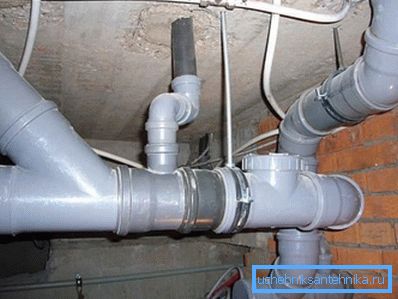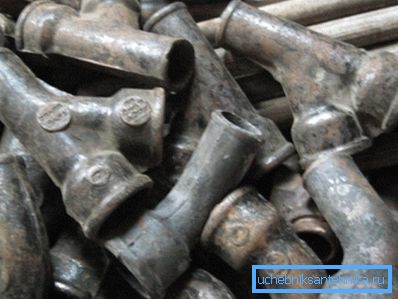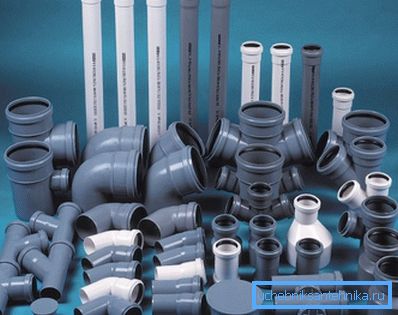What to use pipes for sewage in the construction of a
Starting the construction of their own home, when it comes to the installation of engineering communications, many homeowners are faced with a choice: what material to use and how to choose the most effective pipe diameters for sewage, so that its work does not cause any further problems.
Immediately it should be noted that the issue of arranging the sewage system must be treated with full responsibility, since most of its elements imply a hidden, and in some cases even underground installation, so the cost of an error in this matter can be very expensive.

Overview of materials for the arrangement of sewage
In order to have an idea of the modern ways of installing a system for collecting and recycling domestic wastewater, this article describes all kinds of sewage pipes and connecting fittings made from the most commonly used materials.
In some ways, this description can be regarded as a complete instruction for choosing the most optimal solution for arranging the sewerage system in individual housing construction.

Quality criteria for sewer pipes
The sewage system does not imply periodic replacement and, as a rule, is installed once for the entire settlement period of a residential house operation, therefore the main requirement for such systems is its reliability and durability.
In order to ensure reliable uninterrupted operation and comfortable use of the sewage system, all its component parts must meet certain conditions:
- High strength of the material should provide reliable protection of the system against mechanical damage caused by external and internal factors., since the pipe for sewage in the ground is experiencing high loads as a result of external pressure and seasonal ground movements.
- Absolute tightness it is necessary in order to prevent leakages and breakdown of hydraulic locks, as well as to prevent unpleasant odors from entering the room and to ensure the normal ventilation mode of the fan standpipe.

- The ability to resist the effects of water, acids, alkalis and household chemicals, as well as resistance to soil and atmospheric corrosion.
- Good elasticity and high resistance to low and high temperatures (up to + 100 ° C) to prevent the material from softening when draining hot water, and so that the sewer pipe does not burst when an ice block forms.
- Uniform and smooth surface structure of the inner walls It is necessary to reduce the likelihood of blockage, reduce the resistance to fluid movement and increase system throughput

Tip! If we talk about which pipes are better for sewage, then to the fullest extent all these conditions correspond to pipes and fittings made of polymeric materials with a wall thickness of at least 3.2 mm.
Shaped products from cast iron
Until recently, sewage pipes and fittings made of cast iron were the only material for arranging domestic sewage systems.
At present, sanitary products from this material are obsolete, therefore in modern construction they are practically not used, however, for their comparative analysis, their main positive and negative qualities will be presented here.
- Due to the high strength of the metal, such products are well resistant to significant static loads, however, due to the brittleness of cast iron, they can crack or crack under the influence of a shock load.
- Iron contained in the composition of cast iron actively reacts with water and the electrolyte of the soil, which leads to the intensive formation of foci of atmospheric and soil corrosion. The durability of cast iron products due to the considerable thickness of the metal of the outer walls, which can reach 10-12 mm.

- Due to the large wall thickness and good sound-absorbing ability, cast iron products have a low noise level, so these sewer pipes for internal sewage systems do not require additional noise insulation.
- The bumpy and rough structure of the inner surface has a significant resistance to the movement of domestic wastewater, which is further enhanced after the occurrence of corrosion, adhesion of fat and lime deposits, which in turn leads to a significant narrowing of the internal lumen of the pipe.
- Pig-iron shaped elements resist to high temperatures well, therefore they can receive drains even with boiling water, however, when an ice block is formed, the pipe walls burst and it must be replaced without the possibility of restoration and repair.

Tip! Regardless of the material chosen, in order to ensure the most efficient operation of the entire system, during installation it is imperative to observe the necessary inclination angle of sewage pipes, which, depending on the diameter, should be 1-2 ° from the horizon in the direction of the drain collector.
Pipes and fittings made of polymeric materials
Thanks to modern technologies, a fundamentally new type of sewage systems made of polymeric materials has emerged, which is now widely used for the installation of engineering communications with their own hands in individual residential construction. Most often, sewage pipes and fittings are made of rigid polyvinyl chloride, as well as low and high pressure polyethylene.
All of these materials do not differ in appearance and have similar technical characteristics:
- Sufficient mechanical strength allows you to withstand the internal pressure of the water column and external static loads caused by external pressure or seasonal ground movements when laying underground lines.
- Moderate elasticity leads to local plastic deformation when an ice block occurs, followed by recovery of the shape after the ice is thawed, so that the outer walls of the pipe do not break.
- Absolute resistance to water, acids, alkalis, household chemicals, petroleum products and other corrosive media allows, without limitation, the use of plastic LDPE pipes for sewage of homes and industrial plants.
- The smooth uniform surface structure of the inner walls of the pipe has minimal resistance to the movement of the fluid and does not contribute to the deposition of lime and fatty deposits, which has a positive effect on the durability and throughput of the system as a whole.
- Due to the low weight of the components, the installation of sewer pipes can be performed by one person without any help.

Tip! For the construction of a vertical standpipe and a common drain collector, as well as for connecting a toilet bowl, sewer pipes with a diameter of at least 110 mm should be used, and a diameter of 50 mm is sufficient for connecting all other sanitary devices.
Other custom solutions
In addition to the presented methods of home sewage treatment, there are other options, using atypical and highly specialized materials for individual construction.
- Asbotsementny pipes with a diameter from 100 to 200 mm can be used as drainage system or reception pipe for the stormwater drainage system on a country site.
- Ceramic pipes of baked clay, covered with acid-resistant glaze, most often used for collecting and transporting wastewater of industrial enterprises, but they can also be used for laying the underground home sewage line.
- When underground installation of the main drain collector uses a two-layer corrugated pipe for sewage, which can be located at a considerable depth and withstand high ground pressure.

Conclusion
After reading this article, we can conclude that the most silent sewage pipes are made of cast iron, and in all other parameters, products made of polymeric materials occupy the leading position. To get more detailed information on this issue, you can watch the video in this article or read similar materials on this subject on our website.